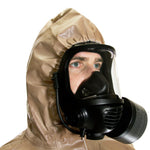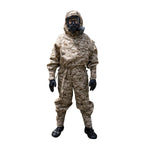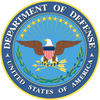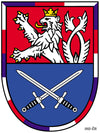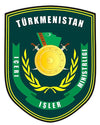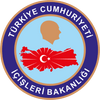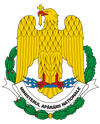The MIRA Safety MOPP-1 CBRN Protective Suit provides next-generation protection from chemical, biological, and even nuclear threats.
Whereas most traditional MOPP Gear is engineered to be impermeable, the MIRA Safety MOPP-1 CBRN Protective Suit has the same advanced semipermeable construction as the suits used by the US Military.
Thanks to its special construction that includes an integrated layer of embedded carbon spheres, this MOPP Gear effectively “breathes” while providing total body protection to the user. As a result, it can be worn for much longer periods in hazardous environments because the risk of exhaustion or dehydration is reduced.
It’s also engineered to be far more durable than the average CBRN MOPP Gear. With its semi-permeable construction, the MOPP Suit is designed to be worn during active duty use and for long periods in response to elevated threat levels. Most hazmat suits are designed for one-time use, but the MIRA Safety MOPP-1 CBRN Protective Suit will last a minimum of 30 days under average use conditions and up to 10 decontamination washes.
If the suit and user are not exposed to direct CBRN threats, the suit can be worn for up to 10 years, presuming it is not damaged or compromised.
Featuring superior puncture resistance and a digital camouflage pattern, the MIRA Safety MOPP-1 CBRN Protective Suit is a top-tier solution that protects against chemical warfare agents (CWA) and toxic industrial chemicals (TIC).
Key Features of the MIRA Safety MOPP-1 CBRN Protective Suit
- Semipermeable construction like the MOPP Suits used by the U.S. military
- Enhanced ventilation enables longer use compared with traditional hazmat suits, even in extreme environments
- Embedded, activated carbon spheres that filter the ambient air
- Designed for long-term use
- Flame retardant, according to ISO 6940:2004
- Can be washed up to 10 times at 40°C (104°F) to decontaminate after potential exposure
- Lightweight (5.5 lbs.) to enable mobility and minimize fatigue
- Integrated hood that adapts to fit respirators
- Compatible with all MIRA Safety gas masks and most CBRN respirators/hoods
- Front zipper with covering flap for easy donning and maximum protection
- One-piece coverall design to reduce the possibility of vapor and gas ingress
- Includes a hermetically sealing storage bag and pump
- Minimum 10-year shelf life when stored in its original packaging in appropriate storage conditions
- Made in the Czech Republic
The Next Generation of Protective CBRN Suits
The MIRA Safety MOPP-1 CBRN Protective Suit delivers protection above and beyond anything else available on the civilian market today.
Indeed, it’s even superior to the protective gear trusted by most military, police, and professional operators worldwide. Most entry-level biohazard suits are only designed to provide limited protection for workers on a job site and are designed to be replaced after a single day’s use, with more focus on affordability than extended protection.
Higher-grade hazmat suits can provide a wider range of protection, but they’re also limited in that they are impermeable. So, in addition to keeping threats out, they keep air out too. As a result, the use time for these types of hazmat suits is limited. When performing work that requires strenuous effort, users can become dehydrated or exhausted after as little as an hour of work.
The first MOPP Suits were developed to solve a specific challenge for the military—allowing soldiers to maintain maximum readiness and mobility without compromising on protection from gas and vapor threats.
The MOPP-1 is the latest evolution of protective suits, engineered to provide all-day comfort and protection from direct exposure to deadly chemical and toxic threats. It’s available in multiple sizes to fit various body types.
When stored in its original packaging in appropriate conditions (see below), the MOPP-1 CBRN Protective Suit will last ten years.
Remember, when wearing a MOPP Suit, users will require the addition of a functioning full-face respirator, a properly CBRN-rated filter, butyl gloves, and boots to ensure proper protection from airborne contaminants, radioactive particles, and other threats.
For storage after use, we recommend purchasing clothing storage bags that are hermetically sealed and come with a hand pump. These bags usually feature a double zip and a triple seal valve, ensuring a perfect hermetically-seal that will reduce the size of your MOPP-1 Suit by up to 50% for easier long-term storage.
MOPP Suit Storage
The MOPP-1 CBRN Protective Suit should be stored either in the original packaging at temperatures from -30°C to +50°C or in a hermetically sealed bag, with a relative humidity of up to 80% and without direct exposure to sunlight or heat sources.
Under these conditions, the suit’s shelf life is at least ten years.
MOPP Suit Cleaning and Maintenance
After exposure or use, the CBRN MOPP-1 Suit should be cleaned and disinfected according to the manufacturer's instructions included with the packaging. Your MOPP-1 Suit can be washed up to 10 times in this manner without compromising its protective abilities. Once a suit has been washed ten times, remove it from rotation. Never use a MOPP Suit that is not properly disinfected and decontaminated. In case of doubt, dispose of the suit in accordance with local regulations, and use a new one. The MOPP-1 Suit requires zero end-user maintenance. If a suit is compromised, torn or cut, DO NOT attempt to repair it.
Technical Specifications
| Structural Parameters | EN ISO | Specification | Tolerance |
| Weave | EN 40161 | Ripstop | |
| Global composition | EN 40110 | 64% Lenzing FR/30% Meta-aramid/5% Para-aramid/1% Antistatic | (+/- 3%) |
| Weight (g/m2) | EN 40339 | 220 | (+/- 5%) |
| Width (cm) | EN 1773 | 155 | (+/- 1%) |
| Mechanical Qualities | Method | Values | |
| Tensile strength warp | EN 13934-1 | 700 N | |
| Tensile strength weft | EN 13934-1 | 500 N | |
| Tear strength warp | EN 13937-2 | 20 N | |
| Tear strength weft | EN 13937-2 | 20 N | |
| Pilling | EN 12945-2 | 5 | |
| Abrasion | EN 12947-2 | >80.000 cycles | |
| Dimensional Stability to Washings | Method | Values | |
| Warp | EN 25077 | <3% | |
| Weft | EN 25077 | <3% | |
| Normative | Level | ||
|
EN 11612 Protective clothing - Clothing to protect against heat and flame.
|
A1 A2 B1 C1 F1 | ||
|
EN 1149-3 Protective clothing - Electrostatic properties - Part 3: Test methods for measurement of charge decay
|
Pass | ||
| Flame Retardant | ISO 6940:2004 |
MOPP-1 TECHNICAL PRODUCT TESTING
samples
The details of the received sample are presented in Table 1.
Table 1: Received sample
| Sample code MIRA | Description by Customer | received |
|---|---|---|
| 21pq0928 | AvEc-Ms-1-BATCH 1 | 04-05-2021 |
Test Method
The detailed description of the test procedures is presented in the Annex.
Results
The test results are presented in the Tables 2 and 3. Note that the test results are only applicable to the tested material, mentioned in Table 1.
Table 2: Laid droplet, diffusive flow HD, 10 g/m? (5% RH, 30°C, 24 hours, 1ul drops)
| Sample code | penetrated amount (ug/cm?) |
|---|---|
| 21PQ0928A | <0.05 |
| 21PQ0928B | <0.05 |
| 21PQ0928C | <0.05 |
Table 3: Vapour test, HD, target concentration 11 mg/m? (80% RH, 30°C, 6 hours, wind speed 5 m/s)
| Sample code | Challenge (mg/m3) |
Velocity through sample (cm/s) |
Penetrated dose (mg.min/m3) |
|---|---|---|---|
| 21PQ0928A | 12 | 0.33 | <3.7 |
| 21PQ0928B | 12 | 0.33 | <3.8 |
| 21PQ0928C | 12 | 0.34 | <3.7 |
Samples
The details of the received samples are presented in Table 1.
Table 1: Received samples
| Sample code | Description by Customer | received |
|---|---|---|
| 20PQ2305 | Outer shell: 0QAMEU0476, open ripstop with DWR&FR finish, new | 04-11-2020 |
| 20PQ2306 | Filter layer: ALLGO0002N, sphere filter, 345 g/m2 3 ply filter with 04-11-2020 non woven white and sphere active carbon and black knit, new | 04-11-2020 |
| 20PQ2307 | Outer shell: 0AAMEU0476, open ripstop with DWR&FR finish,pie 10x washed ISO 6330, 4N, tumbler dry low temperature | 04-11-2020 |
| 20PQ2308 | Filter layer: ALL60002N, sphere filter, 345 g/m2 3 ply filter with non woven white and sphere active carbon and black knit, 10x washed ISO 6330, 4N, tumbler dry low temperature | 04-11-2020 |
Test Method
The detailed description of the test procedures is presented in the Annex.
Results
The test results are presented in the Tables 2 through 9. Note that the test results are only applicable to the tested materials, mentioned in Table 1.
Table 2: Laid droplet, convective flow 5 m/s, HD, 10 g/m? (80% RH, 30°C, 24 hours, 1)
| Sample code | State | Velocity through sample (cm/s) |
Penetrated dose (mg.min/m3) |
|---|---|---|---|
| 20PQ2306/20PQ2305A | New | 2.2 | 482 |
| 20PQ2306/20PQ2305B | New | 2.2 | 347 |
| 20PQ2306/20PQ2305C | New | 2.3 | 485 |
| 20PQ2308/20PQ2307A | Washed10x | 1.3 | 181 |
| 20PQ2308/20PQ2307B | Washed10x | 1.3 | 268 |
| 20PQ2308/20PQ2307C | Washed10x | 1.5 | 292 |
Table 3: Vapour test 5 m/s, HD, target concentration 11 mg/m? (80% RH, 30°C, 6 hours)
| Sample code | State | Challenge (mg/33) |
Velocity through sample (cm/s) |
Penetrated dose (mg.min/m3) |
|---|---|---|---|---|
| 20PQ2306/20PQ2305A | New | 11 | 2.2 | 65 |
| 20PQ2306/20PQ2305B | New | 11 | 2.6 | 80 |
| 20PQ2306/20PQ2305C | New | 11 | 2.8 | 107 |
| 20PQ2308/20PQ2307A | Washed10x | 11 | 1.3 | 25 |
| 20PQ2308/20PQ2307B | Washed10x | 11 | 1.3 | 14 |
| 20PQ2308/20PQ2307C | Washed10x | 11 | 1.5 | 28 |
Table 4: Vapour test 1 m/s, HD, target concentration 55 mg/m? (80% RH, 30°C, 6 hours)
| Sample code | State | Challenge (mg/33) |
Velocity through sample (cm/s) |
Penetrated dose (mg.min/m3) |
|---|---|---|---|---|
| 20PQ2306/20PQ2305A | New | 56 | 0.11 | <12 |
| 20PQ2306/20PQ2305B | New | 56 | 0.11 | <12 |
| 20PQ2306/20PQ2305C | New | 56 | 0.9 | <14 |
| 20PQ2308/20PQ2307A | Washed10x | 56 | 0.7* | <20 |
| 20PQ2308/20PQ2307B | Washed10x | 56 | 0.7* | <20 |
| 20PQ2308/20PQ2307C | Washed10x | 56 | 0.7* | <20 |
Due to equipment restrictions, the minimum flow of 50 ml/min (= 0.07 cm/s) was applied, instead of the required 42-48 ml/min.
Table 5: Vapour test 5 m/s, GD, target concentration 11 mg/m® (80% RH, 30°C, 6 hours
| Sample code | State | Challenge (mg/33) |
Velocity through sample (cm/s) |
Penetrated dose (mg.min/m3) |
|---|---|---|---|---|
| 20PQ2306/20PQ2305A | New | 11 | 1.8 | 60 |
| 20PQ2306/20PQ2305B | New | 11 | 1.9 | 51 |
| 20PQ2306/20PQ2305C | New | 11 | 1.9 | 68 |
| 20PQ2308/20PQ2307A | Washed10x | 11 | 1.6 | 38 |
| 20PQ2308/20PQ2307B | Washed10x | 11 | 1.5 | 48 |
| 20PQ2308/20PQ2307C | Washed10x | 11 | 1.5 | 29 |
Table 6: Vapour test 1 m/s, GD, target concentration 55 mg/m3 (80% RH, 30°C, 6 hours)
| Sample code | State | Challenge (mg/33) |
Velocity through sample (cm/s) |
Penetrated dose (mg.min/m3) |
|---|---|---|---|---|
| 20PQ2306/20PQ2305A | New | 55 | 0.07 | <14 |
| 20PQ2306/20PQ2305B | New | 55 | 0.10 | <10 |
| 20PQ2306/20PQ2305C | New | 55 | 0.10 | <10 |
| 20PQ2308/20PQ2307A | Washed10x | 55 | 0.07* | <16 |
| 20PQ2308/20PQ2307B | Washed10x | 55 | 0.07* | <16 |
| 20PQ2308/20PQ2307C | Washed10x | 55 | 0.07* | <16 |
Due to equipment restrictions, the minimum flow of 50 ml/min (= 0.07 cm/s) was applied, instead of the required 42-48 ml/min.
Table 7: Laid droplet 0.5 m/s diffusive flow HD, 10 g/m? 30°C, 24 hours, 1ul drops)
| Sample code | State | Penetrated amount (ug/cm2) |
|---|---|---|
| 20PQ2306/20PQ2305A | New | <0.08 |
| 20PQ2306/20PQ2305B | New | 1.0 |
| 20PQ2306/20PQ2305C | New | <0.08 |
| 20PQ2308/20PQ2307A | Washed10x | <0.08 |
| 20PQ2308/20PQ2307B | Washed10x | <0.08 |
| 20PQ2308/20PQ2307C | Washed10x | <0.08 |
Table 8: Laid droplet 0.5 m/s, diffusive flow GD, 10 g/m? (80% RH,30°C, 24 hours, 1ul drops)
| Sample code | State | Penetrated amount (ug/cm2) |
|---|---|---|
| 20PQ2306/20PQ2305A | New | 0.53 |
| 20PQ2306/20PQ2305B | New | 0.32 |
| 20PQ2306/20PQ2305C | New | 0.14 |
| 20PQ2308/20PQ2307A | Washed10x | 0.12 |
| 20PQ2308/20PQ2307B | Washed10x | <0.06 |
| 20PQ2308/20PQ2307C | Washed10x | 0.10 |
Table 9: Laid droplet, diffusive flow LVAP, VX, 10 g/m? (5% RH, 30°C, 24 hours, 1ul drops)
| Sample code | State | Penetrated amount (ug/cm2) |
|---|---|---|
| 20PQ2306/20PQ2305A | New | 1.0 |
| 20PQ2306/20PQ2305B | New | 0.93 |
| 20PQ2306/20PQ2305C | New | 0.21 |
| 20PQ2308/20PQ2307A | Washed10x | 0.30 |
| 20PQ2308/20PQ2307B | Washed10x | 0.41 |
| 20PQ2308/20PQ2307C | Washed10x | 0.48 |
PRODUCT CARE INSTRUCTIONS
- PREPARE ITEM BY ZIPPING UP ALL POCKETS
- WASH IN WARM WATER ONLY
- NO DETERGENT
- TUMBLE DRY UNTIL ITEM IS THOROUGHLY DRY
MOPP Suit Size Guide
The MOPP-1 CBRN Protective suit is available in three different sizes (available as size pairs):
- Small - Medium (SM/MD)
- Large - Extra Large (LG/XL)
- 2X Large -3X Large (2XL/3XL)
| SM/MD | LG/XL | 2XL/3XL | ||||
| Chest Girth- measures over the biggest bulk of the breast just under the armpit | 78-86 | 86-94 | 94-102 | 102-110 | 110-118 | 118-129 |
| Waist Girth- measures the smallest part of the upper body | 66-74 | 74-82 | 82-90 | 90-98 | 98-106 | 106-117 |
| Person's Height- measures the total length from the head to ground | 156-164 | 164-172 | 172-180 | 180-188 | 188-196 | 196-204 |
| ***Dimensions in cm | ||||||
Mission Oriented Protective Posture (MOPP) Protective Levels Guide
In the US Army, understanding MOPP levels is crucial for personnel to maintain safety during various exercises and real-world scenarios. MOPP is a commonly used acronym for mission-oriented protective posture and outlines the required garments, gear, and actions airmen must take in response to different levels of hazard. This includes donning overboots for additional protection and being prepared for various threats such as radiation, nerve agents, and biological threats. Implementing these protocols effectively ensures that soldiers are ready to respond to emergencies.
For instance, Airman 1st Class personnel must be familiar with each MOPP level, from MOPP Level 0, where minimal personal protective equipment (PPE) is necessary, to MOPP Level 4, which demands full gear, including a protective mask and gloves. These measures ensure that airmen are prepared to handle harmful threats such as biological agents at an air base. Emergency management protocols often highlight the importance of these levels in article displays to ensure that every airman knows how to properly use their MOPP kit. The following table provides a detailed overview of each MOPP level, ensuring that airmen are always ready to protect themselves and continue their mission effectively.
| Level | What's Worn | Description |
| MOPP 0 | Carry a protective mask. | Ensure that individual protective gear is within arm's reach. |
| MOPP 1 | Suit worn. Mask, gloves, and boots carried. | Airmen wear the suit and carry the mask, gloves, and boots, preparing for potential hazards. |
| MOPP 2 | Suit and boots are worn. Gloves and mask carried. | Airmen wear the suit and boots, while carrying gloves and mask, ready for an increased threat level. |
| MOPP 3 | Suit, boots, and mask worn. Gloves carried. | Airmen wear the suit, boots, and mask, with gloves carried, indicating a high threat of hazardous exposure. |
| MOPP 4 | All protection is worn. |
|
Mastering MOPP Levels: Essential CBRN Gear for Military Readiness
Understanding and implementing MOPP levels isn't just about following procedures; it's about ensuring readiness and safety in unpredictable environments. It's far better to know how to wear protective gear and not need it than to need it and not be able to properly wear it. It's important to remember that being prepared can make all the difference in critical situations. Stay ready by familiarizing yourself with MOPP protocols and practicing regularly.
Given that world politics are changing, we may or may not resort to these protective measures frequently, but we must be vigilant. Knowing what our enemies may deploy in terms of chemical, biological, or radiological threats is crucial. Therefore, understanding and being proficient in MOPP levels ensures that you can respond effectively when needed. Remember, it's always better to be over-prepared and safe than caught off-guard and vulnerable.

